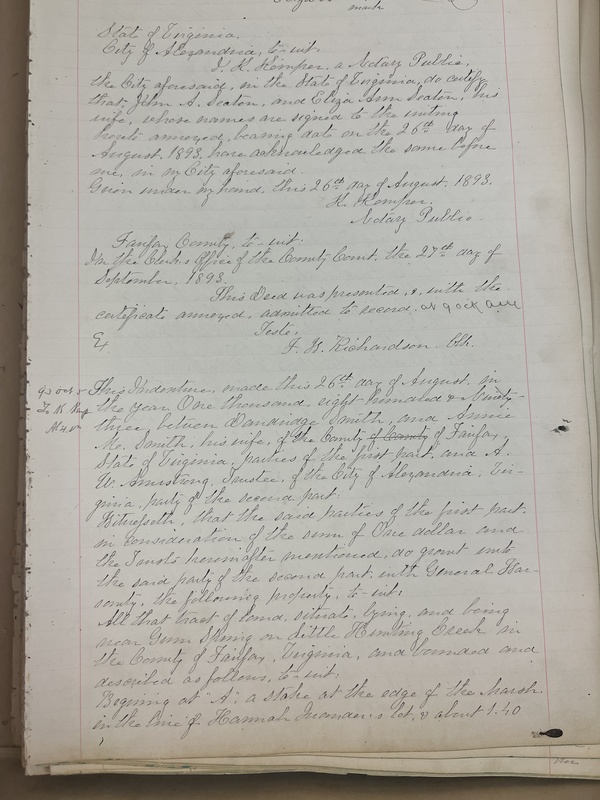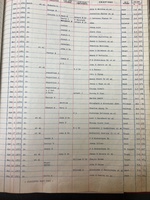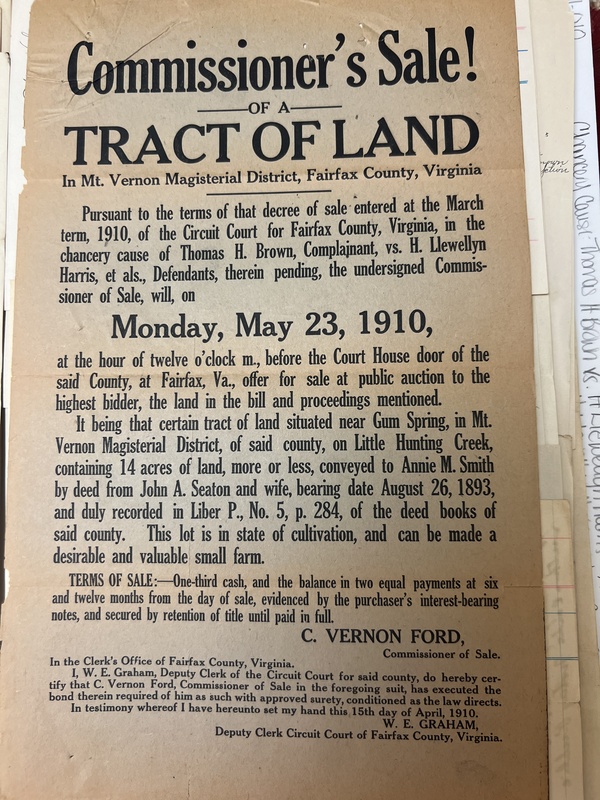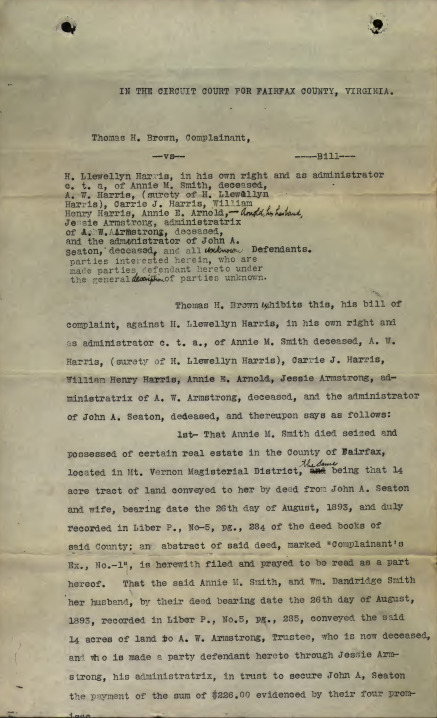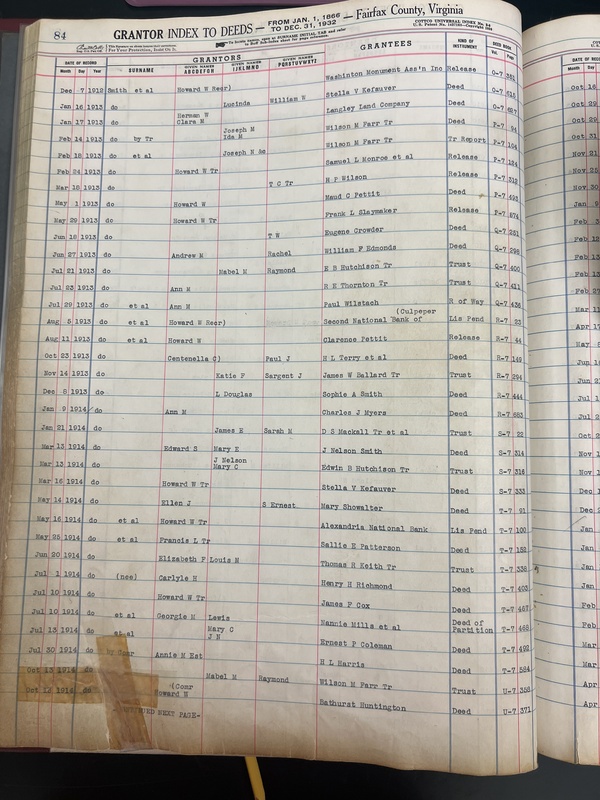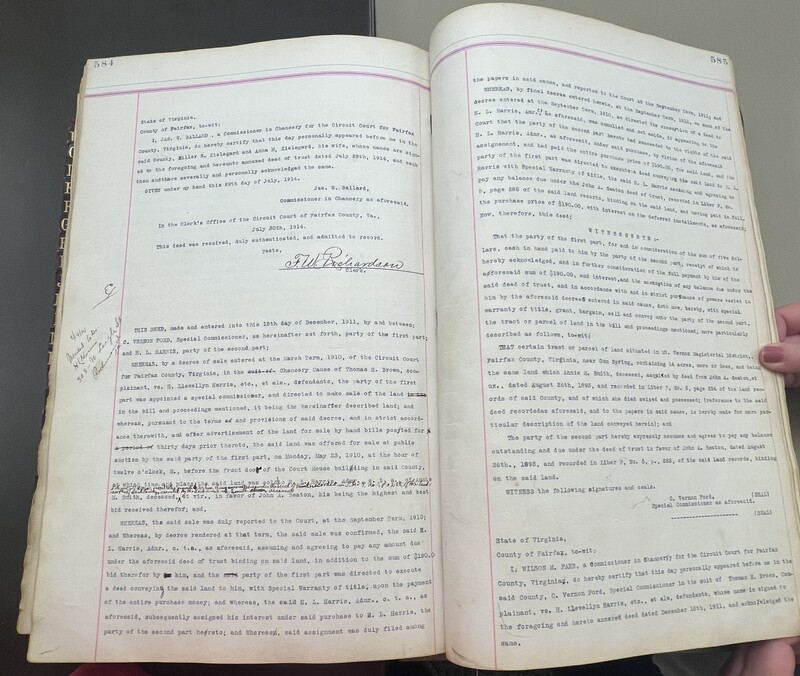Smith Family Land and Business
The first time Dandridge Smith shows up in the deed records is in 1893 when taking out a trust with his wife, Annie M. Smith. They used the trust to purchase the 14.95-acre property from John A. Seaton. When searching further back in the Grantee and Grantor Indexes, evidence showed that John A. Seaton had initially purchased the property from Daniel Ford in 1866, a son of West Ford, and the uncle of Dandridge. The reason that Dandridge’s land does not show up in the deed records is because his land was inherited and not purchased or sold by him or to him.
After the deaths of Dandridge and Annie Smith, the estate was posted on a “Commissioner’s Sale Advertisement”. This sale advertisement was held by C. Vernon Ford. C. Vernon Ford was the executor, “a lawyer, and the Commonwealth’s Attorney for Fairfax County from 1897 to 1922” (C. Vernon Ford- Fractured Fairfax). There was a chancery case in 1910 in reference to the land after the sale advertisement was posted. This is because after Annie’s death, multiple people wanted to make a claim to the land. Chancery courts address estate and land disputes which is why this particular case went through chancery court. When the case was settled, I the court ordered that half an acre of land was to be saved as a burial plot for the Smith’s close relatives as stated in Annie M. Smith’s will. The rest of the land was divided between her nieces and nephews, Carrie J. Harris, H. Llewellyn Harris, William Henry Harris, and Annie E. Arnold. Her will stated that the land will be “invested in a building association for each until they shall become 21 years of age”. Annie M. Smith’s name remained in the Land Tax Record books even after her death, because not all of her nieces and nephews had turned 21 yet so the property was still legally hers. A 1914 deed contract confirmed that one part of the land now belonged to H.L. Harris (one of Annie’s nephews). This is important because he was the only one that was old enough to inherit the land at this time.
Further research could be done on what the property is used for in current times. It is not known what the Harris family decided to do with the land or if the land is still being used for farming. Other further research could be done on what happened to Dandridge’s 12-acres of land. His land could not be found formally documented in the Grantee or Grantor Indexes at the Historic Record Center.
[1] “C. Vernon Ford - Fractured Fairfax.” Accessed November 30, 2023. https://www.fracturedfairfax.com/C._Vernon_Ford.html.
[2] Casper, Scott E., and Loren Schweninger. “Out of Mount Vernon’s Shadow: Black Landowners in George Washington’s Neighborhood, 1870–1930.” In Beyond Forty Acres and a Mule, edited by Debra A. Reid and Evan P. Bennett, 39–62. African American Landowning Families since Reconstruction. University Press of Florida, 2012. https://www.jstor.org/stable/j.ctvx0716s.10.
[3]Chancery Records Index, 1910, Fairfax County Historic Records Center, Fairfax, Virginia.
[4]Contract Record in Mount Vernon Magisterial District for the Year 1914, 1914, Fairfax County Historic Records Center, Fairfax, Virginia.
[5] Deed from Annie M. Smith to H.L. Harris, Fairfax Deed Book, Fairfax County Historic Records Center, Fairfax, Virginia.
[6] Grantee Index to Deeds "Sm-" from 1866-1932 page 57, 1893, Fairfax County Historic Records Center, Fairfax, Virginia.
[7] Grantor Index to Deeds "Sm-" from 1866-1932 page 84, 1914, Fairfax County Historic Records Center, Fairfax, Virginia.
[8] Trust Contract from A. W. Armstrong to Dandridge and Annie M. Smith, Fairfax Deed Book, Fairfax County Historic Records Center, Fairfax, Virginia.
[9] Virginia Chancery Records in Mount Vernon Magisterial District for the Year 1910, 1910, Fairfax County Historic Records Center, Fairfax, Virginia.
Jamie Van Cleave
